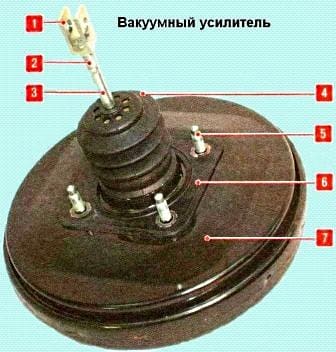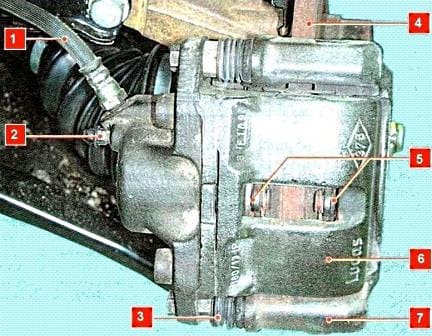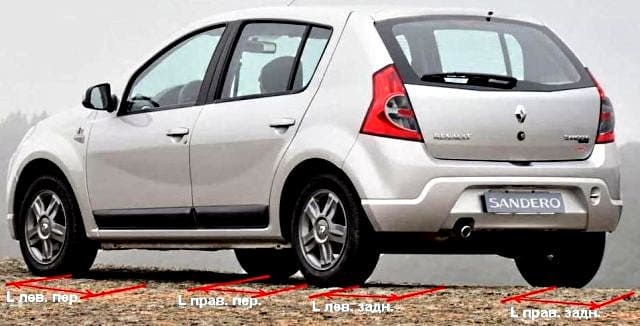Renault/Dacia Sandero is equipped with two independent braking systems: working and parking.
The first, equipped with a hydraulic drive with a vacuum booster, provides braking when the car is moving, the second slows down the car in the parking lot.
Dual-circuit working system with a diagonal connection of the brake mechanisms of the front and rear wheels.
One hydraulic circuit provides the right front and left rear brakes, the other - the left front and right rear.
If one of the circuits of the service brake system fails, the second circuit is used to stop the car with sufficient efficiency.
Brake pedal - suspension type.
A brake light switch is installed in the pedal assembly bracket above the brake pedal - its contacts close when the pedal is depressed.

To reduce the effort on the brake pedal, a vacuum booster is used, using the vacuum in the receiver of a running engine.
The vacuum booster is located in the engine compartment between the pedal pusher and the main brake cylinder and is attached with four nuts (through the bulkhead) to the pedal bracket.
The vacuum amplifier is non-separable, it is replaced in case of failure.

The main brake cylinder is fastened with nuts to two studs of the vacuum booster housing.
On top of the cylinder there is a reservoir of the hydraulic drive of the brake system, in which there is a supply of working fluid.
The tank body is marked with maximum and minimum liquid levels, and a sensor is installed in the upper part, which, when the liquid level drops below the MIN mark, turns on the signaling device in the instrument cluster.
When the brake pedal is pressed, the pistons of the master cylinder move, creating pressure in the hydraulic drive, which is supplied through pipes and hoses to the working cylinders of the wheel brakes.

The brake mechanism of the front wheel is disc, with a floating caliper, which includes a caliper, made together with a single-piston wheel cylinder.
The brake shoe guide is attached to the steering knuckle with two bolts, and the bracket is attached with two bolts to the guide pins installed in the holes of the shoe guide.
Protective rubber covers are installed on the fingers.
Grease is placed in the holes for the pins of the shoe guide.
When braking, the fluid pressure in the hydraulic drive of the brake mechanism increases and the piston, moving out of the wheel cylinder, presses the inner brake pad against the disc.
Then the bracket (due to the movement of the guide pins in the holes of the guide pads) moves relative to the disc, pressing the outer brake pad against it.
A piston with a rectangular rubber sealing ring is installed in the cylinder body.
Due to the elasticity of this ring, a constant optimal gap is maintained between the disc and the brake pads.

The brake mechanism of the rear wheel is drum, with a two-piston wheel cylinder and two brake shoes, with automatic adjustment of the gap between the shoes and the drum.
The brake drum is also the hub of the rear wheel and the bearing is pressed into it.

The pressure regulator changes the pressure in the hydraulic drive of the rear wheel brakes depending on the load on the rear axle of the car.
It is included in both circuits of the brake system, through it the brake fluid flows to both rear brake mechanisms.
The regulator is bolted to the car body.
Its rod is connected to the rear suspension beam through a spring-loaded load rod, lever 4 and an earring.
Depending on the distance between the beam and the body, which depends on the vehicle load, the regulator rod moves, which, in turn, with the help of a valve system, changes the cross-sectional area of the passage channels of the circuits inside the regulator, thereby limiting the pressure in the rear brake circuits.
The degree of restriction of the regulator, and, consequently, the pressure in the circuits is regulated by changing the length of the regulator stem with a nut.
The wheel cylinders of the brake mechanisms of the rear wheels are the same.
The front pads of the brake mechanisms of the rear wheels are the same, while the rear ones are different - they are mirror-symmetrically equipped with non-removable parking brake levers.
The spacer bar and ratchet nut of the left and right wheel brakes are different.
The ratchet nut and lug of the left wheel spacer bar are left hand threaded, while the ratchet nut and lug of the right wheel spacer bar are right hand threads.
The levers of the brake mechanisms of the left and right wheels are mirror-symmetrical.

Anti-lock braking system (ABS) consists of a hydro-electronic unit 1 (fig. 6) with hydraulic solenoid valves, wheel speed sensors, an electrically driven pump and signal lamp 4 in the instrument cluster.
The anti-lock braking system is used to regulate the pressure in the brake mechanisms of all wheels when braking in difficult road conditions, preventing the wheels from blocking.
ABS provides the following benefits:
- - obstacle avoidance with a higher degree of safety, including during emergency braking;
- - reduction of the braking distance during emergency braking while maintaining roadholding and controllability of the car, including when turning.
In the event of a system failure, a function is provided to maintain operation in case of system failures.
The hydroelectronic control unit receives information about vehicle speed, direction of travel and road conditions from wheel speed sensors
Based on this information, the control unit determines the optimal wheel braking mode, changing the flow area of the circuits with the help of electromagnetic valves, anticipating the moment of blocking the wheel that slows down rotation, which prevents it from blocking.
If the system expects a wheel to be blocked, it instructs the appropriate valve to isolate the fluid supply to that wheel's slave cylinder from the brake master cylinder.
If a wheel's speed continues to decrease relative to the other wheels, the ABS system returns the brake fluid back to the master cylinder, reducing braking.
If all four wheels decelerate equally, the return pump will shut off and all solenoid valves will open again, allowing the brake master cylinder to act on the slave cylinders normally.
This cycle can repeat up to ten times per second.
Turning on the solenoid valves and the return pump creates pulsations in the hydraulic drive of the brake system, they are transmitted to the brake pedal, thereby signaling to the driver that the ABS is working.
The solenoid valves in the circuits of the brake mechanisms of the front wheels act on their working cylinders independently, on each separately, while the solenoid valve of the circuits of the brake mechanisms of the rear wheels acts on both working cylinders of the mechanisms simultaneously.
Because the brake system is diagonally split, a separate mechanical plunger valve in the hydraulic block separates the hydraulic output of the rear solenoid valve into two separate circuits. to prevent false signals from affecting the system, the built-in safety loop monitors all signals entering the control unit.
If a false signal is received or the voltage in the on-board electrical network is insufficient, the system is automatically turned off, the ABS deactivation warning lamp in the instrument cluster lights up.
In this case, the normal operation of the brake system is maintained, however, when driving on a slippery road, you need to be extremely careful, since the distribution function of the system will be impaired (the function of equalizing the pressure in the brake mechanisms of the front and rear wheels) and there is a possibility of skidding the car when braking.
Parking brake drive - manual, mechanical, cable, on the rear wheels.
It consists of a lever, a front cable with an adjusting nut on its tip, an equalizer, two rear cables and levers in the rear wheel brakes.
The parking brake lever, fixed between the front seats on the floor tunnel, is connected to the front cable.
An equalizer is attached to the rear end of the front cable, into the holes of which the front ends of the rear cables are inserted.
The rear cable ends are connected to the parking brake levers attached to the rear shoes.
During operation (until the rear brake pads are completely worn out), adjustment of the parking brake drive is not required, because. extension of the brake spacer compensates for pad wear.
The parking brake actuator only needs to be adjusted if the cables or the parking brake lever have been replaced.
The stroke of the brake pedal with the engine running should be approximately 60-65 mm.
Too little stroke indicates an incorrect initial setting of the brake pedal, a violation of the adjustment of the vacuum brake booster or a seizure of the working cylinder, causes increased fuel consumption and accelerated wear of the brake pads.
Too much stroke is a sign of excess clearances in the pedal mechanism or a leak in the hydraulic drive of the brake system.
If the stroke decreases when the pedal is pressed repeatedly, i.e. it becomes "harder" in the air system.
If the full pedal travel starts to increase, the system is leaking.
If the brake pedal always starts to vibrate when braking, most likely the brake discs are warped.
In such a situation, you only need to change them, and both at once.
Pedal vibration that appears and disappears periodically during hard braking accompanies the operation of the anti-lock brake system and is not a sign of a malfunction.
If the car starts to pull to the side when braking, check the working cylinders; they may need to be replaced.
If there is a knock in the front suspension that disappears when braking, check the tightness of the caliper mounting bolts.
Before you start moving after replacing the brake pads, be sure to press the brake pedal several times - the pistons in the working cylinders should fall into place.
Possible malfunctions of the brake system and methods of correction
Cause of malfunction - Remedy
Increased brake pedal stroke:
Leakage of brake fluid from working brake cylinders - Replace failed working brake cylinders,
Rinse and dry pads, discs and drums
Air in the brake system - Bleed the system
Rubber o-rings in brake master cylinder damaged - Replace master cylinder
Damaged rubber brake hoses - Replace the hoses and bleed the system.
Increased runout of the brake disc (more than 0.03 mm) - Grind or replace the disc if the thickness of the braked discs of the front of the wheels is less than 19.8 mm
Insufficient braking performance:
Oiling the brake pads - Wash and dry the pads
Jamming of pistons in working cylinders - Eliminate the causes of jamming, replace damaged parts
Complete wear of the brake pads - Replace the brake pads
Brake overheating - Stop immediately and let the brakes cool down
Using low quality lasts - Use origi pads or products of firms specializing in the production of parts for brake systems
Violation of the tightness of one of the circuits (accompanied by the failure of the brake pedal) - Replace damaged parts, bleed the system
Brake pedal misalignment - Determine the cause of the increase in full travel and replace the damaged parts
Violation of the adjustment of the protrusion of the rod of the vacuum brake booster - Contact the service to adjust the booster
Anti-Lock Braking System (ABS) Malfunction - Contact a Service Center to Check Your Anti-Lock Braking System
Incomplete release of all wheels:
No free play on brake pedal - Replace brake master cylinder
Increased protrusion of the vacuum brake booster rod - Contact the service to adjust the booster
Swelling of the rubber seals of the main cylinder due to the ingress of gasoline, mineral oils, etc. into the liquid. - Flush and bleed the entire hydraulic drive system, replace rubber parts
Jammed master cylinder pistons - Check and replace master cylinder if necessary
Braking one wheel with the pedal released:
Broken or loose parking brake shoe return springs - Replace spring
Piston sticking in the working cylinder due to contamination or corrosion of the body - Replace the working cylinder and bleed the hydraulic brake system
Swelling of the sealing rings of the working cylinder due to the ingress of foreign impurities into the liquid - Replace the working cylinder and bleed the hydraulic brakes
Violation of the position of the caliper relative to the brake disc when the mounting bolts are loosened - Tighten the mounting bolts, if necessary, replace the damaged parts
Incorrect parking brake adjustment - Adjust the parking brake
Anti-Lock Braking System Abnormality - Have an Anti-Lock Braking System Test
Sliding or pulling the car to the side when braking:
Jamming of the piston of the working cylinder - Check and eliminate the jamming of the piston in the cylinder
Clogging of any tube due to dent or blockage - Replace or clean tube
Dirty or oily discs, drums and brake pads - Clean brake parts
Wheels out of alignment - Adjust wheel alignment
Various tire pressure - Set the required tire pressure
One of the brake circuits does not work (accompanied by a decrease in braking efficiency) - Replace damaged parts and bleed the system.
If this does not lead to the desired result, contact the service to check the anti-lock brake system (if installed on the car)
Increased brake pedal force when braking:
Vacuum booster defective - Replace booster
The hose connecting the vacuum booster and the engine intake pipe is damaged or its fastening is loose - Replace the hose
Swelling of rubber cylinder seals due to the ingress of gasoline, mineral oils, etc. into the liquid. - Replace cylinders, flush and bleed the system
Squeak or vibration of the brakes:
Oiling the friction linings - Clean the linings with a wire brush using warm water and detergent.
Remove the causes of fluid or grease getting on the brake pads
Worn pads or foreign matter in them - Replace the pads
Excessive runout or uneven wear (felt by vibration of the brake pedal) of the brake disc - Grind or replace the disc if the thickness of the brake discs of the front wheels of cars with K7J and K7M engines is less than 10.6 mm, cars with K4M engine is less than 17.7 mm
Checking the brakes
It is advisable to check the operation of the brake system on special brake stands.
An approximate assessment of the operation of the brake system can be performed on a flat horizontal area (preferably covered with a thin layer of sand), buried for traffic.
This test can be performed on vehicles without ABS.
With ABS, the check is carried out at the service station using diagnostics.
After braking the car, get out of the car and inspect the brake marks left by the car's wheels.

If the brake tracks of the front wheels are slightly longer than the rear ones, and the length of the tracks on the left and right is the same, then the brake system is working.
If not, repair the system.
The following ratios must be respected:
- - L lion. per. = L right. trans.
- -La lion. rear = L right. rear
- - L lane > L rear
If the same check on a car equipped with ABS shows brake marks as clearly as when checking a car without ABS, then the anti-lock brake system is faulty.
In this case, you need to contact the service station for ABS repair.




